How to Perform a Fall Protection Harness Inspection
Do you know the rejection criteria for your fall protection harness? There are many types of damage that independently of each other, will require a harness be removed from service.
“We do not rise to the level of our expectations. We fall to the level of our training.”
Greek lyric poet Archilochus was not talking about personal fall protection equipment when he coined this phrase, but his words do ring true when it comes to wearing safety equipment, including harnesses, while working at height.
Harnesses are a critical piece of “personal fall protection,” and full-body harnesses are approved for use in:
- Fall arrest
- Positioning
- Confined space rescue
- Ladder climbing devices
It is key to keep harnesses in proper working condition because doing so could be the difference between making it home safely after completing a day’s work, and not making it home at all due to a failure in personal fall protection equipment leading to injury or death.
In this article, we will look at the following:
- What personal fall protection equipment needs to be inspected?
- If a harness tag is legible, what happens next?
- What type of inspections shall a harness receive?
- Who performs harness inspections?
- What are the requirements for a harness inspection?
What Personal Fall Protection Equipment Needs to Be Inspected?
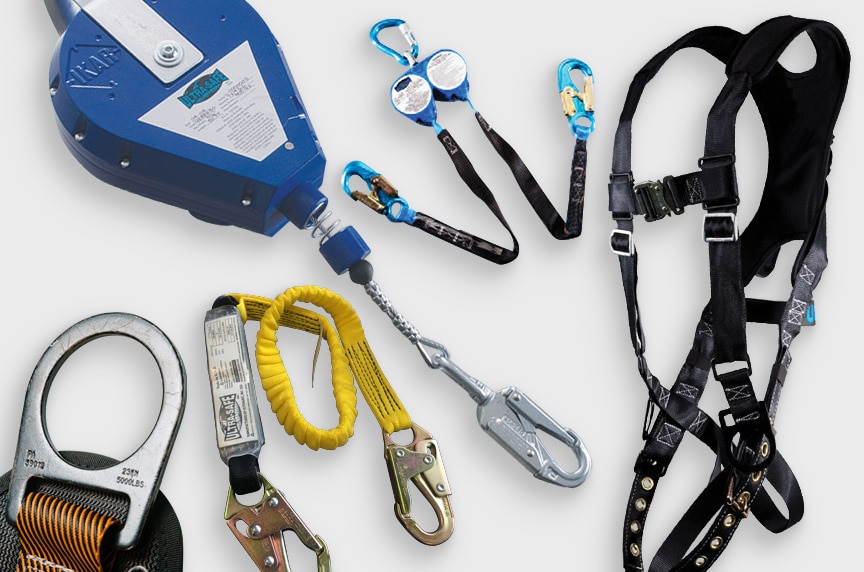
Along with doing rigging inspections, Mazzella also performs personal fall protection soft goods inspections. Soft goods include inspections on the following:
- Harnesses
- Lanyards
- SRL Retractables
The manufacturer’s tag is a common place to start a visual inspection on any harness. The No. 1 point of emphasis is seeing that the tag is absolutely clear and legible. Inspectors will make sure the following information is legible:
- Manufacturer’s name
- Unique serial number (because that has to be traceable back to the manufacturer and all the materials used to make the harness)
- Model number of the harness
- Sizing
- Date of manufacture
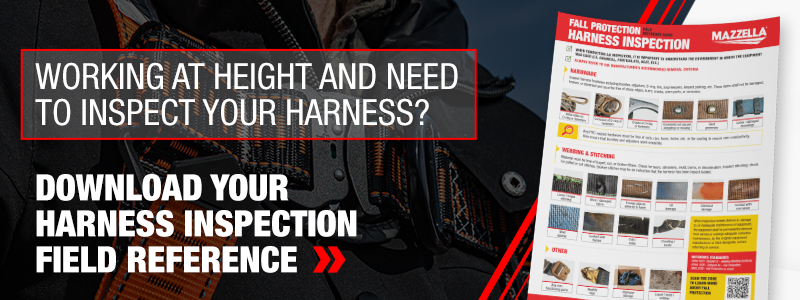
What Happens If a Harness Tag Is Legible?
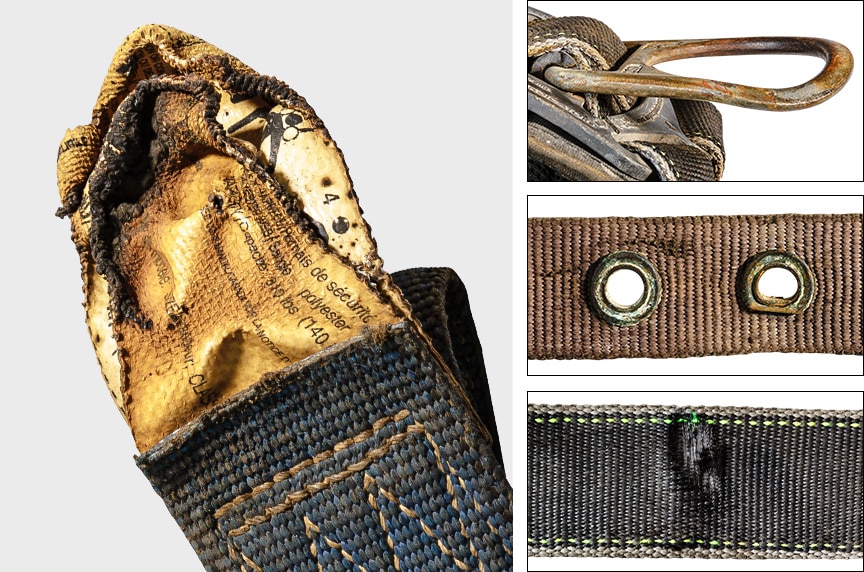
If everything is legible on the tag and the harness is not disqualified from service, inspectors will conduct a “hand-over-hand” inspection. In most cases, that will be a gloveless inspection because they need to feel the material to accurately judge its structural integrity. In highly volatile or hazardous facilities, including but not limited to chemical or sewage treatment plants, certain precautions will be taken by inspectors.
- Deformities on D-ring or fasteners
- Corrosion of D-ring or fasteners
- Cracks in D-ring or fasteners
- Grommets not secure (wiggling) or missing
- Bent grommets
- Loose / damaged mountings
Then, inspectors will work through the different portions of the webbing feeling for any heat damage, while looking for:
- Loose / frayed stitching
- Worn / damaged fabric
- Foreign objects adhered to fabric
- UV (ultraviolet) damage
- Chemical damage
- Contact with corrosives
- Weld splatter
- Contact with flames
- Cuts / holes
- Crushing / knots
As an end-user, you want to be mindful of the end to the sewing pattern of the harness. There might be a little piece of stitching hanging out where the manufacturer snipped it. It may be a little long, so you just want to make sure that it’s not pulling apart.
Remember, if a harness is involved in a fall, it should be removed from service and replaced.
Other Factors to Consider
Something else to take into account is the type of harnesses being inspected. Some elaborate harnesses might have tool belts. You can have a little damage to a non-load bearing portion of your harness. But again, if you found that damage, there’s a really strong chance that it occurred elsewhere on the harness.
At the end of the visual inspection of a harness, if the tag reads legible, and no damage was found, inspectors will document this as a “pass” and leave it in service.
What Type of Inspections Shall a Harness Receive?
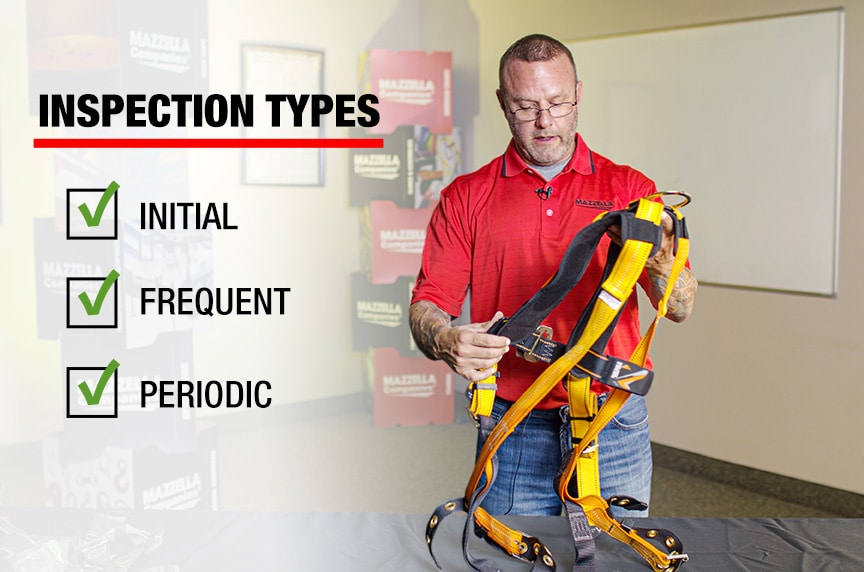
There are three types of inspections a harness shall receive before and during its service life:
- Initial
- Frequent
- Periodic
Initial Inspection
The initial inspection is going to be when you receive the harness from the manufacturer or distributor. You want to make sure it’s the right harness, meaning the correct size and model for yourself or your employees. During these inspections, you want to make sure there are no visible defects, especially with the sewing, stitching patterns.
Frequent Inspection
The frequent inspections would take place before daily use of the harness. This inspection will not be dependent on how much the harness is worn, but when the individual goes to put it on for the first time of any given day. End-users should inspect it hand over hand, just as is the case with a periodic inspection.
It is suggested that depending on the application where the harness is used that an inspection occurs after it is removed for the day because there are situations where harnesses are shared. You want to make sure if you put a harness back on the shelf after you are done using it that it is safe to use again.
Periodic Inspection
At a minimum, a periodic inspection is needed once every, and not to exceed 12 months. A periodic inspection is a documented hand-over-hand inspection of each harness. The frequency of the harness inspection is determined by the frequency and severity of its use. Environmental factors will determine how frequently these inspections are necessary.
Who Performs the Different Harness Inspections?
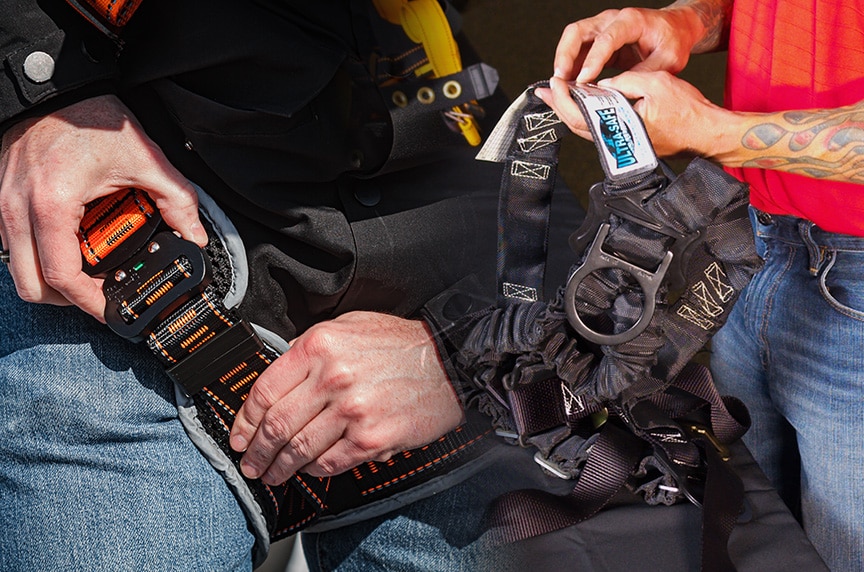
Generally speaking, the end-user will play a large role in the inspection process because they need to inspect their harness before putting it on, as well as after it is removed if it’s a shared harness. Also, end-users will conduct initial inspections of new harnesses to check for defects, and proper fit before it is first put into service.
For periodic inspections, third-party companies are often hired to conduct and document their findings on personal fall protection equipment. All of our inspectors go through the proper training, and are deemed competent by Mazzella Lifting Technologies. When a customer hires a third-party company to do their periodic inspections, they have designated that company to do the inspection, and make determinations on the service life of personal fall protection equipment.
What Are the Requirements for a Harness Inspection?
Basically, it is a pass-or-fail situation. The harness is either in satisfactory shape, or it’s not. In a worst-case scenario, the harness is going to keep you from going over a leading edge, or it is going to keep you protected in a fall.
During periodic inspections, inspectors are ensuring all decisions made about the harness provide the maximum safety protection during in-field use. That is why having a legible tag is extremely important because in the documented report, you have to list the following:
- Name of the manufacturer
- Serial number
- Model number
- Date of manufacture
- Size
Frequently Asked Questions
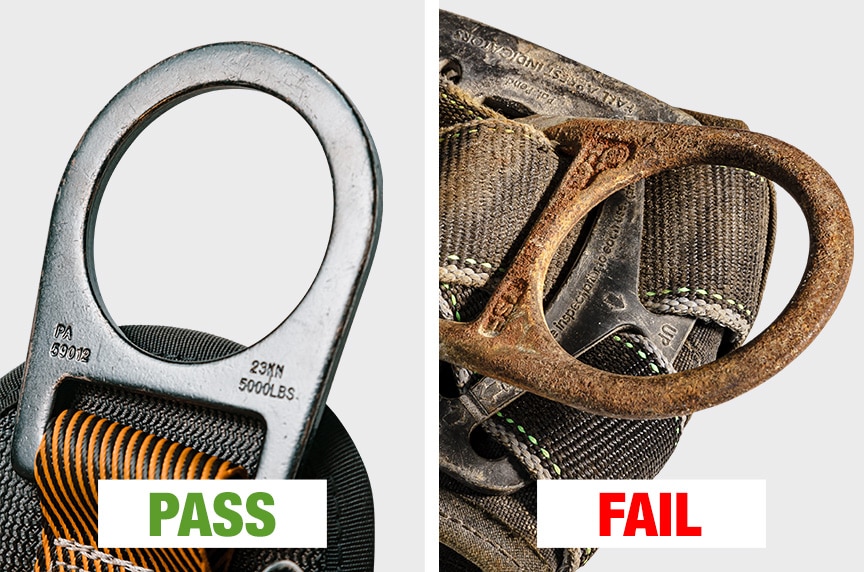
Is There a Governing Body that Provides Harness Requirements?
Yes, there are two standards that govern requirements on a harness. The first is OSHA (the Occupational Safety and Health Administration) and ANSI Z359 from the American National Standards Institute. Additionally, there are manufacturer’s requirements, as well as your own internal requirements based on environmental factors that determine harness requirements.
ANSI/ASSE Z359.2-2017-Minimum Requirements for a Comprehensive Managed Fall Prevention Program is a standard that defines who is required to do on-site inspections of the conditions of the fall prevention systems in use.
“Fall prevention equipment shall be inspected by the authorized person at least once at the beginning of each eight-hour shift in which it is used to verify that it has not sustained any wear or damage that would require its removal from service. Fall prevention and fall rescue equipment shall be inspected on a regular basis not to exceed one year (or more frequently if required by the manufacturer’s instructions) by a competent person or a competent rescuer, as appropriate, to verify that the equipment is safe for use.”
In addition, remember to refer to the manufacturer’s operating manual to aid with proper care and use of the specific device(s).
Who Should Companies Look to in Order to Find Recommendations for Harnesses?
As an end-user, you want to speak with a fall protection specialist about harnesses because there is a lot that goes into the:
- Selection of a harness
- Proper fitment of a harness
- Application of the harness
What Are the Most Common Reasons for a Harness to Be Rejected?
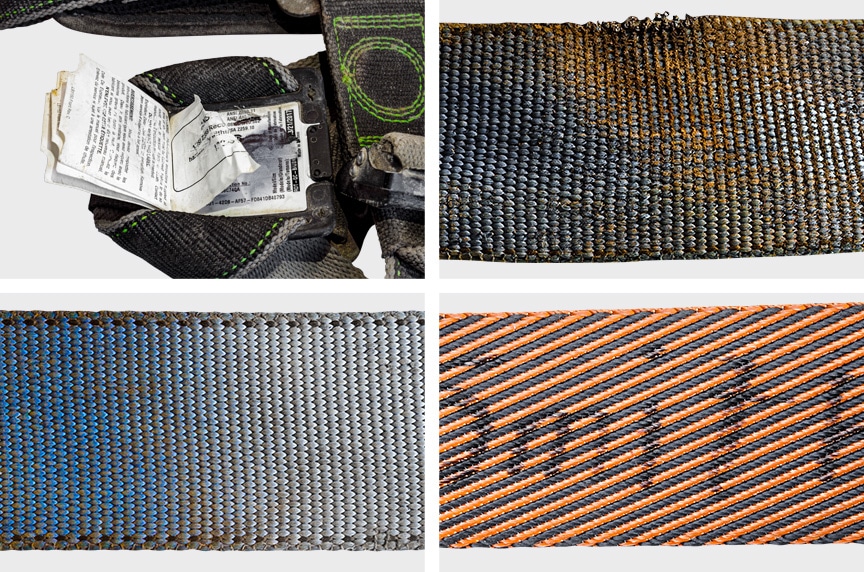
The most common reasons a harness will be disqualified from service are:
- Illegible tag
- Heat damage
- UV damage
- People writing on their harness with a marker on the load-bearing webbing
What it comes down to is one will never really be able to prove what marker was used to make a mark on the harness webbing. Therefore, one can only go in the direction of some chemical was introduced, and some level of damage is possible.
Are Written Records of Inspections Required?
Yes. Written records are required for your periodic inspections. You should have a copy of the most recent periodic inspection on file. Mazzella recommends you keep the inspection records year over year.
Can a Harness Be Returned to Service?
The only time a harness can be returned to service is if it has passed the visual inspection.
While there have been discussions about this, the person conducting the harness inspections has been deemed the competent person at that time. They’re making the decision. No person in your organization can overturn their decision.
Why Is Personal Fall Protection so Important?
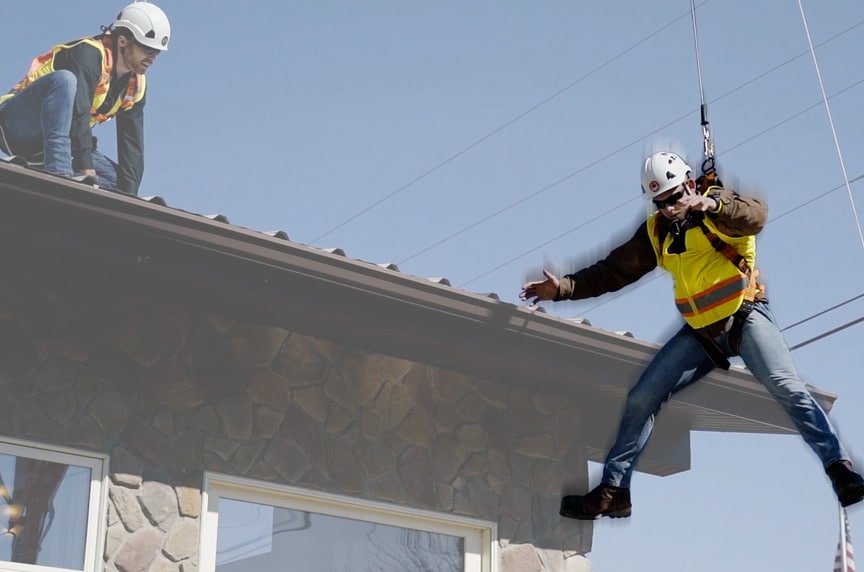
According to OSHA Publication 2056, there are nearly 6,000 workplace fatalities in the United States and 50,000 deaths due to workplace-related illnesses each year. Also, there are 5.7 million non-fatal workplace injuries, and those injuries alone cost U.S. businesses over $125 billion annually.
Falls are the leading cause of death in the construction industry, and most fatalities happen when employees fall from open-sided floors and through floor openings. Falls from as little as 4’ to 6’ can cause long-term time away from work, or death, which means all open-sided floors and platforms 6’ or more in height must be guarded.
Personal fall protection involves the use of several components, including:
- Harness
- Lanyard
- Self-retracting lanyard (SRL)
- Anchor point
Anchor Point
Anchor points serve as the secure point for lanyards, lifelines, or other deceleration devices, which is part of the short lanyard attached to the rope grab and full-body harness.
There are two types of anchor points:
- Temporary
- Permanent
With temporary anchor points, employees should use solid structures, such as structural support members.
Permanent anchorage points must be designed by a qualified person and approved by a registered professional engineer. These points must have a safety factor of at least twice the maximum anticipated force during a fall.
When Are Harnesses Required to Be Used?
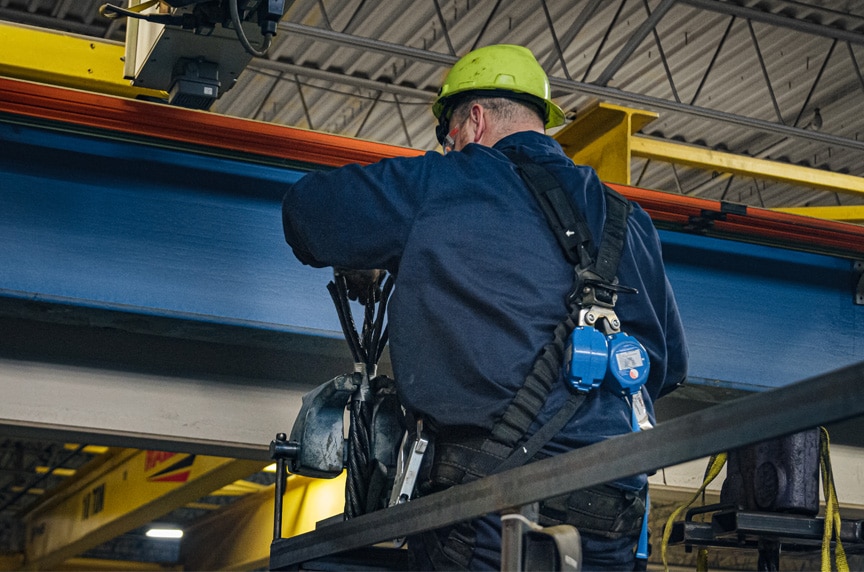
ANSI defines an “active” fall protection system as “a means of providing fall protection that requires workers to take specific actions, including wearing, and otherwise using personal fall protection equipment and following prescribed procedures. Examples include travel restraint and fall arrest systems.”
OSHA 1926.501(M) defines fall protection as being the responsibility of “each employee on a walking / working surface (horizontal and vertical surface) with an unprotected side or edge which is 6’ (1.8 m) or more above a lower level shall be protected from falling by the use of guardrail systems, safety net systems, or personal fall arrest systems.”
Harnesses and lanyards are used when working on jobs that have a risk of a fall hazard that can’t be removed.
According to the ANSI/ASSP Z359.11 standard, “full body harnesses (FBHs) should be used in occupations requiring personal protection against falls from heights, and if required, shall allow for the specialized functions of travel restraint, positioning, suspension, and / or rescue.”
How Can Mazzella Help with Harness Inspections?
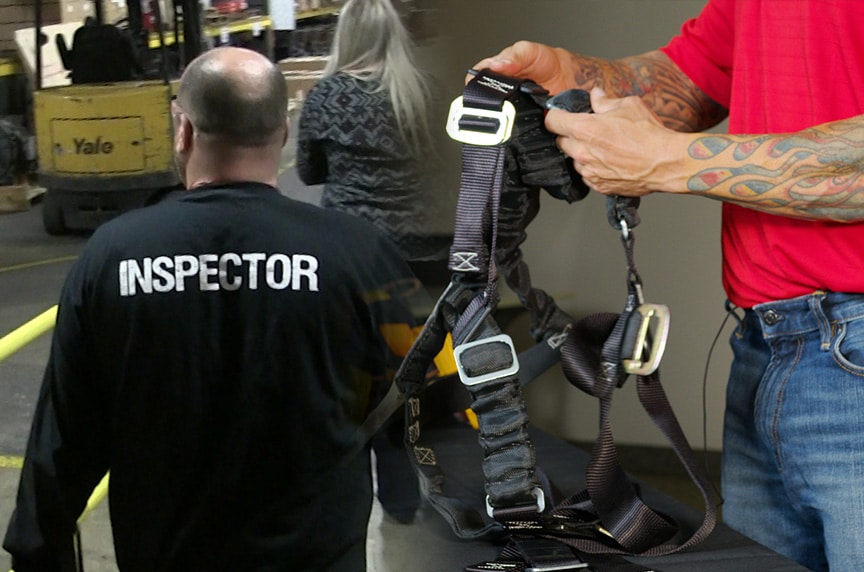
Rigging inspections are what Mazzella is known for. However, personal fall protection inspections pair well with our rigging inspections.
What our rigging inspectors have found over the years is that while looking at all the rigging in a facility, many of the workers using this rigging also use personal fall protection. Through our personal fall protection inspection training, we are competent to conduct these inspections.
Also, Mazzella provides personal fall protection solutions and engineered lifeline systems to help keep your employees safe at heights.
We are a leading supplier and installer of engineered fall protection systems in the U.S., as well as a distributor of soft goods like harnesses, lanyards, self-retracting lifelines, scaffolding and netting. All of our engineered systems and products meet or exceed the federal criteria required by OSHA and ANSI, and can be customized with your personal fall protection and financial needs in mind.
We work with our partners to provide full-body harnesses, as well as many other fall protection products. As workers move at height, these products are designed to secure them when and where a fall may occur.
Call us at 800.362.4601 or click here if you need harnesses or other fall protection equipment!
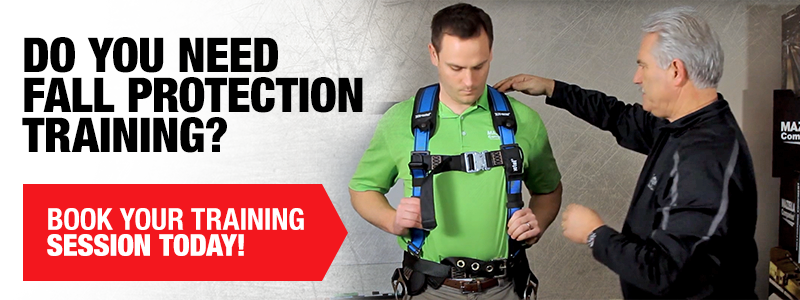

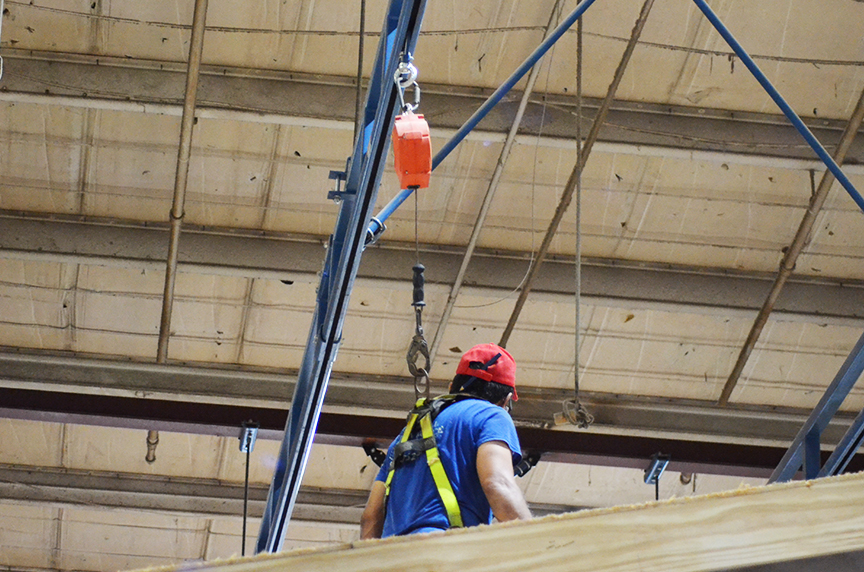
Fall Protection
We are a leading supplier and installer of engineered fall protection systems in the U.S., as well as a distributor of soft goods like harnesses, lanyards, self-retracting lifelines, scaffolding, and netting.
Copyright 2022. Mazzella Companies.
